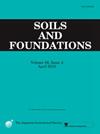风沙中螺旋桩的试验与数值研究:承载性能与设计方法
IF 3.3
2区 工程技术
Q2 ENGINEERING, GEOLOGICAL
引用次数: 0
摘要
在风沙中,螺旋锚的力学行为涉及复杂的性能演化机制,目前尚未完全了解。本研究采用现场试验、数值模拟和机器学习相结合的多尺度综合方法,系统研究螺旋锚杆承载行为的演化规律。结果表明:(1)螺旋锚在风沙中的临界嵌入深度阈值为H = 5D;超过这个阈值,载荷方向效应可以忽略不计。(2)多板螺旋锚具有显著的几何非线性叠加行为。密间距(S/D < 4)产生显著的应力叠加效应(η = 1.15 ~ 1.32),宽间距(S/D≥4)产生独立的承载单元(η = 0.97 ~ 1.03)。(3) XGBoost机器学习模型识别出内摩擦角、锚板直径和嵌入深度比是影响承载力的最重要特征。基于这些控制参数,建立了承载力系数Nq和土侧摩擦系数Ku的预测方程,预测结果与试验数据吻合良好。这为工程师提供了基于性能的设计的可靠分析框架。该研究不仅加深了对风沙中螺旋桩行为机理的认识,而且为岩土工程实践提供了切实可行的解决方案。本文章由计算机程序翻译,如有差异,请以英文原文为准。
Experimental and numerical study on helical piles in aeolian sand: bearing behavior and design methods
In aeolian sand, the mechanical behavior of helical anchors involves complex performance evolution mechanisms that are not yet fully understood. This study employs a multi-scale integrated approach combining field tests, numerical simulations, and machine learning to systematically investigate the evolution laws of the bearing behavior of helical anchors. The results indicate: (1) The critical embedment depth threshold for helical anchors in aeolian sand is H = 5D; beyond this threshold, the load direction effect can be neglected. (2) Multi-plate helical anchors exhibit significant geometrically nonlinear superposition behavior. Dense spacing (S/D < 4) produces notable stress superposition effects (η = 1.15–1.32), whereas wide spacing (S/D ≥ 4) results in independent bearing units (η = 0.97–1.03). (3) The XGBoost machine learning model identifies the internal friction angle, anchor plate diameter, and embedment depth ratio as the most influential features affecting bearing capacity. Based on these control parameters, predictive equations for the bearing capacity coefficient Nq and soil lateral friction coefficient Ku were developed, with predictions showing excellent agreement with experimental data. This provides engineers with a reliable analytical framework for performance-based design. The study not only deepens the understanding of the behavioral mechanisms of helical piles in aeolian sand but also offers practical solutions for geotechnical engineering practice.
求助全文
通过发布文献求助,成功后即可免费获取论文全文。
去求助
来源期刊

Soils and Foundations
工程技术-地球科学综合
CiteScore
6.40
自引率
8.10%
发文量
99
审稿时长
5 months
期刊介绍:
Soils and Foundations is one of the leading journals in the field of soil mechanics and geotechnical engineering. It is the official journal of the Japanese Geotechnical Society (JGS)., The journal publishes a variety of original research paper, technical reports, technical notes, as well as the state-of-the-art reports upon invitation by the Editor, in the fields of soil and rock mechanics, geotechnical engineering, and environmental geotechnics. Since the publication of Volume 1, No.1 issue in June 1960, Soils and Foundations will celebrate the 60th anniversary in the year of 2020.
Soils and Foundations welcomes theoretical as well as practical work associated with the aforementioned field(s). Case studies that describe the original and interdisciplinary work applicable to geotechnical engineering are particularly encouraged. Discussions to each of the published articles are also welcomed in order to provide an avenue in which opinions of peers may be fed back or exchanged. In providing latest expertise on a specific topic, one issue out of six per year on average was allocated to include selected papers from the International Symposia which were held in Japan as well as overseas.
 求助内容:
求助内容: 应助结果提醒方式:
应助结果提醒方式:


